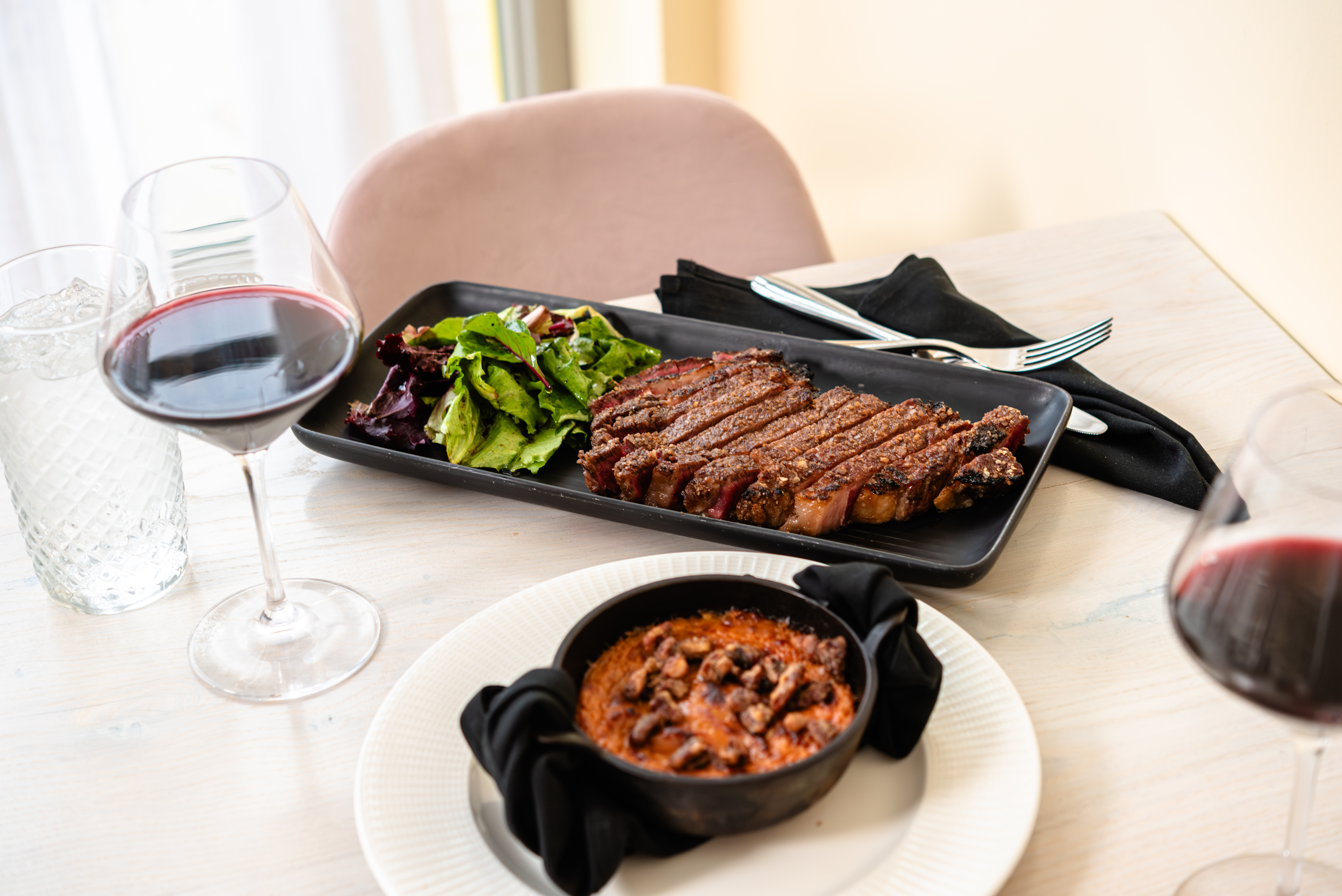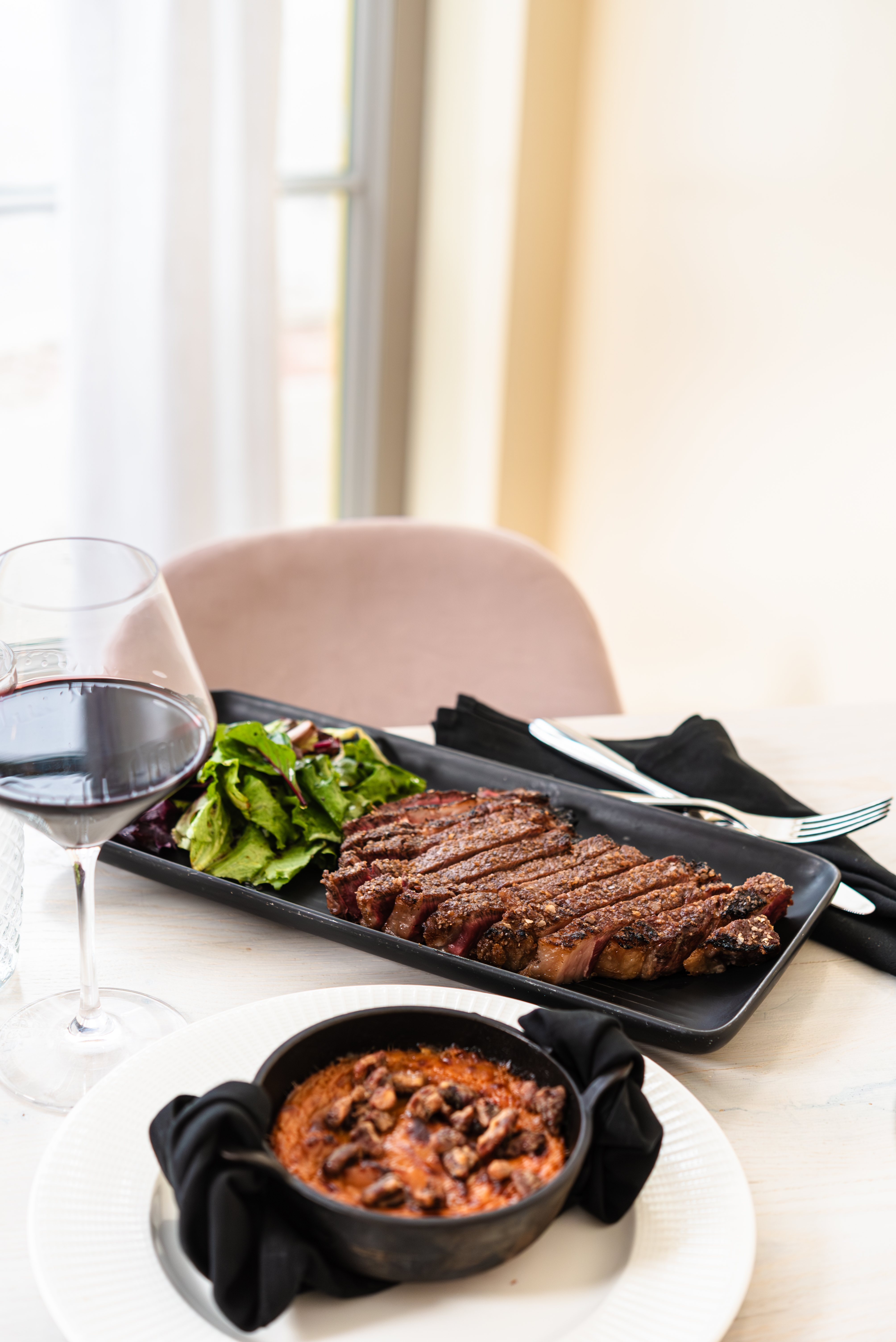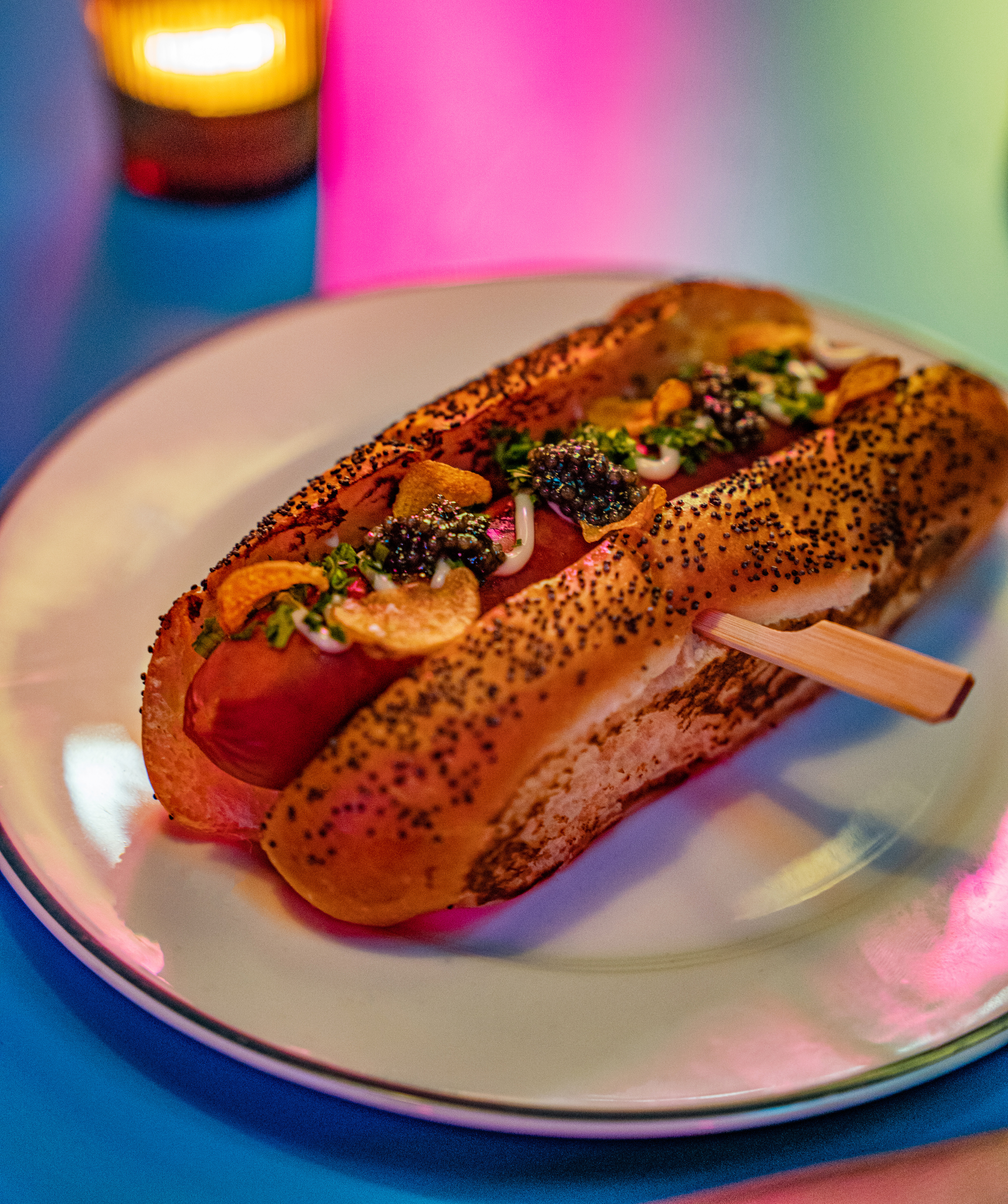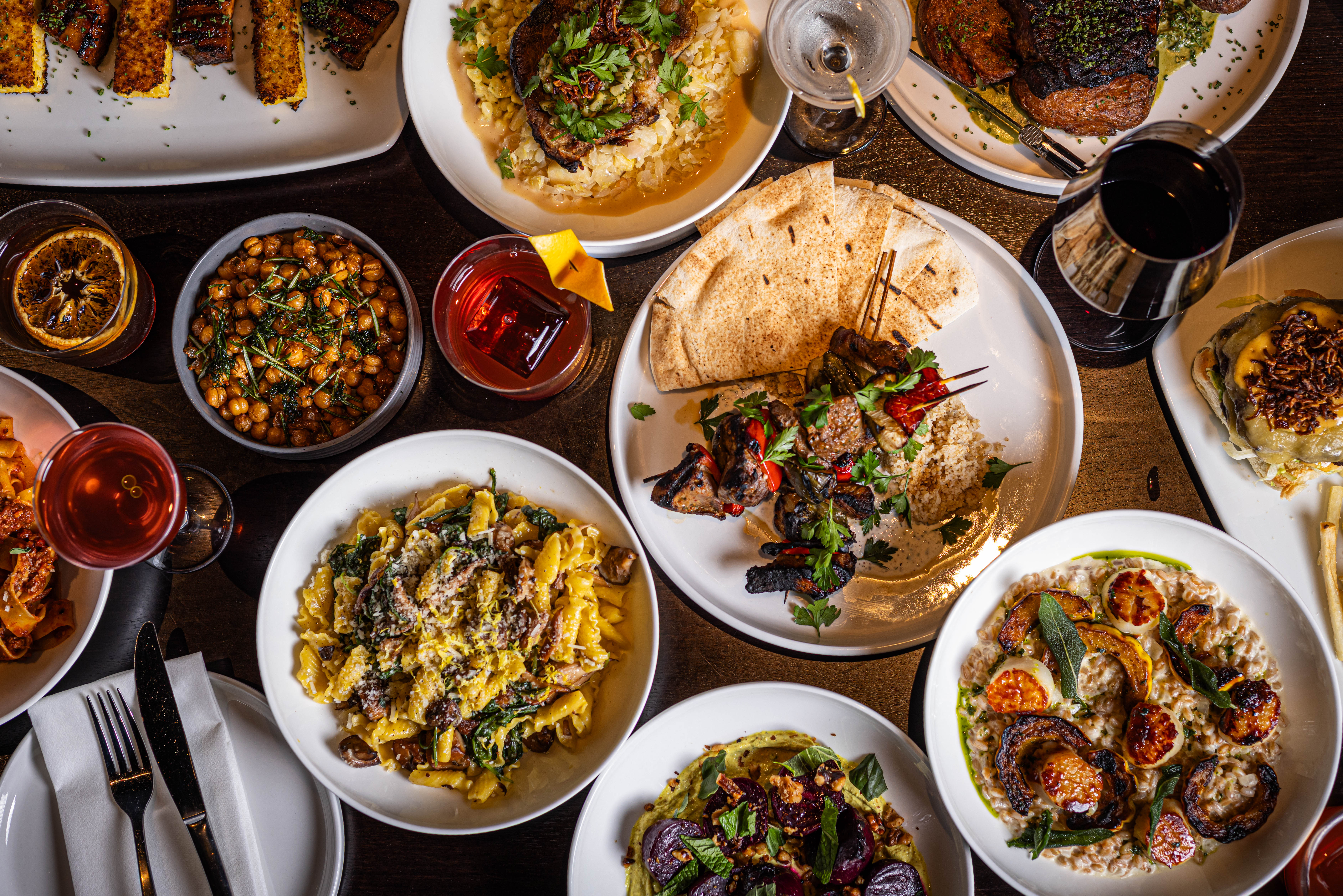On the Hunt
by Laura Adiletta | Aug. 17, 2015 | 4:00 AM
Chef Demetrios Atheneos is the embodiment of the ebullient, food-loving Greek. The dark-complexioned, heavyset 40-year-old waxes on about potatoes in the way a car enthusiast might about engine parts — not as cogs in a larger, flashier wheel but as vital components every bit as cool on their own.
"We'll take an ingredient like sweet potatoes," he says. "What can we do to the sweet potatoes? Can we make a pasta out of it? Can we make a puree out of it? Can we make a soup out of it? And break down each ingredient that way."
He's at home in a pinstriped apron and clogs, striding enthusiastically around Forage Public House, the local food spot he opened in a former Pacer's Ribhouse in Lakewood last December.
He reaches into his pockets to find his phone, showing off a recent photo of him breaking down a whole hog and gesticulating grandly to emphasize its size.
Atheneos steps over to a hulking piece of machinery and lifts off its plastic cover, beckoning inspection of the prize underneath: a Berkel hand-crank meat slicer — cherry-red and Italian-made.
"This is our bad boy," he says. "This sucker costs seven grand new. It's our baby."
If the name Atheneos doesn't sound familiar, you haven't been paying enough attention. After stints at Giovanni's Ristorante in Beachwood, Bodega in Cleveland Heights and his own short-lived Bella Luca in Lakewood, he was tapped in 2010 to help open one of the area's first true gastropubs: Deagan's Kitchen and Bar, located just 500 feet from Forage's front door.
Following on the heels of the trend started a decade earlier in other parts of the nation, Deagan's helped shift perceptions about fine dining here in Cleveland, inserting denim and chalkboards into the world of polished wood and white tablecloths. Two years later, Atheneos left for his own venture, opening the Oak Barrel in Valley View and changing the chain-restaurant landscape there.
"You can go into any of my restaurants and wear jeans and a T-shirt or a suit, and you'll feel comfortable either way," he explains. "I could sense that the market was changing and people were changing. We went through a huge recession. I kind of was like, Maybe there's a thing to all this upscale casual, gastropub feel."
For the native of Boca Raton, Florida, casual was already king. On the other hand, having to design menus around seasonality and availability wasn't a concern until his move to Cleveland in the early 2000s. He's been building relationships with local vendors such as Tom Wiandt, owner of Killbuck Valley Mushrooms in Burbank, Ohio, ever since.
"I was buying mushrooms from him when I first moved here, and I still buy mushrooms from him for both my restaurants today," he says. "In Florida, I didn't really have that. If I had moved to a different state, maybe I wouldn't be that much into [local foods]."
Atheneos pivots, swinging his hand back to reveal a small walk-in cooler toppling with bins of fresh produce, containers of various liquids and packages of all sizes wrapped in plastic. It's tight — barely large enough for two to stand shoulder-to-shoulder inside — but neat. Unexpectedly, he declares his pride not in the organization or the ingredients within, but in the refrigerator's diminutive size.
"We receive everything on Tuesday. By Sunday, it's empty," he says. "That's the best way to keep it fresh. If you don't have tons of space, you won't fill it up with nonsense."
That approach might come as a surprise to anyone who's seen the menu at Forage, which is loaded with about seven dozen options, most of which feature a melange of ingredients. There are 12 starters, a host of choices for charcuterie and cheeses, 10 salads, four fish entrees, six meat and game dinners, seven sandwiches, a burger menu with 20 toppings, five sides and four desserts, not to mention daily chalkboard specials.
Yet the manic menu belies the care with which Atheneos treats each ingredient, both in the cooler and on the plate. This is true for the most expensive dish on the menu (a $28 hanger steak) as well as its humbler items such as a colorful and shockingly flavorful roasted vegetable dish ($9) featuring roasted carrots, peppers, potatoes and Jerusalem artichokes. Nothing is under- or over-seasoned, knife cuts are precise, and not a bruise or a wilted leaf is in sight.
In the quest to achieve that level of freshness, provenance reigns here — which perhaps should be expected of a restaurant called Forage. To a fault, nearly every ingredient on the menu is labeled with its point of origin. There's trout from Homestead Springs in Fredericktown, baby lettuces from Chef's Garden in Huron, and chorizo from just behind the swinging stainless steel doors: Melissa Khoury, owner of artisan charcuterie Saucisson, trained staff and developed recipes for all the meats and sausages, which are made and lovingly sliced in-house.
"There are a lot of chefs out there that are a part of the farm-to-table movement, but we're almost like a small farm-to-table concept ... as well as foraged items," says Atheneos.
Foraged ingredients have been the talk of the town lately, particularly since Jonathon Sawyer snagged a James Beard award with his hyperlocal, experimental menu of barks and fungi and roughage. By contrast, Forage eases diners into the concept, satisfying even the type of diners who give Trentina a wide berth.
For instance, a rabbit loin dish ($24) from Briarwood Valley Farms in Sullivan, Ohio, proves that game can be simultaneously mellow and developed, with moist, savory meat without an overwhelming funky, earthy undertone. It's even more approachable with a crispy batter coating that delivers crunch and foraged huckleberries — akin to blueberries, though smaller and a little more tart — and a savory espresso stock to meld it all together.
But beyond some wild greens, a handful of rare mushrooms and two types of huckleberries, much of which is available year-round from famed vendor Joe Daugherty in Portland, Oregon, foraged items here are somewhat limited — despite the restaurant's name. The food has wide appeal, although a few more risks would be welcome to further distinguish the restaurant's personality.
Still, it's hard to complain. A crisp wild yellow perch ($18) — caught from somewhere along Ontario's 2,300-plus-mile coastline — is fish and chips that transcends the pub menu, with a sublimely airy coating, fresh and mild fish flavor and a bold if heavy-handed dollop of pickled chile crema reminiscent of dynamite sauce.
Anyone who abstains from meat will have more than the obligatory vegetarian pasta dish to choose from as well. A full 70 percent of the menu is vegetarian- or vegan-friendly.
Atheneos' large hands rummage through a box of Chef's Garden baby vegetables waiting to be pickled in the 25-ingredient brine that makes up the popular daily pickles ($5). Baby leeks so thin they look like scallions, tiny fennel plants displaying telltale fronds, multicolored carrots the size of a thumb — they all look laughably small. In this kitchen, they're a big deal.
"I kind of look at it as a chef's forage," he says. "Not only foraging wild for ingredients but just sourcing and the basic principal behind what Forage is, and that's sourcing all of our products from sustainable farms and fisheries, feeling good about what you're selling and being able to tell everybody what they're eating and where it came from."
When You Go
Forage Public House, 14600 Detroit Ave., Lakewood, 216-226-2000, foragepublichouse.com, Mon-Thu 11 a.m.-10 p.m., Fri and Sat 11 a.m.-11 p.m., Sun 11 a.m.-9 p.m.
try this: The single origin Belgian chocolate creme ($9) is not your average creme brulee. It's made with a mixture of highest-quality cocoa and whole chocolate, whipped into a flawlessly creamy custard and garnished with a layer of crispy sugar.
good to know: Forage has a firm grasp on alliterative menu specials. Come in for Taco Tuesday (taco specials all day), Wine Down Wednesday (half off bottles until 9 p.m.), Vegan Thursday (vegan specials starting at 5 p.m.) and Hoppy Happy Hour (beer specials from 3-6 p.m. weekdays).
A Few of Our Favorite Things
Forage Public House chef and owner Demetrios Atheneos gives us the rundown on some of his favorite foraged or locally sourced ingredients.- Huckleberries: These tiny, dark purple berries look like a cross between currants and blueberries and have a tart, intense flavor with a slightly seedy texture. "We get two different types, coastal and mountain huckleberries, both [foraged] from Oregon," says Atheneos. "The mountains are a little bit plumper, and the coastal are smaller and more tart." Find it in sauces, such as the one accompanying the restaurant's rabbit loin entree.
- Trout: Forage serves fish from Ohio's first trout farm, Homestead Springs. "Farm-raised fish doesn't taste like wild fish," Atheneos warns, which often surprises patrons who have experience fishing, cleaning and cooking their own line-caught trout. The flesh is pink, almost like salmon, and entirely contained in pens fed by natural springwater near Mansfield.
- Ground beef: One of Forage's most popular menu items - probably due in part to the long list of accompanying topping options — is its burger. "Our burger grind that we make in-house is from New Creations Farm [in Chardon]," he says. So you can always expect humanely raised beef from a single point of origin for good, clean eating.
- Mushrooms: Fungi at Forage is sourced either from wild foragers in the Pacific Northwest or from Killbuck Valley Mushrooms in Burbank, Ohio. "Those change, depending on what comes in that week," he says, including such off-the-beaten-path varieties as Egyptian walking mushrooms and clamshells, as well as better-known culinary species like porcini, hen of the woods and wild oysters.
- Chef's Garden baby vegetables: From turnips to fennel to carrots, squash, leeks and radishes, Chef's Garden supplies most of Forage's picture-perfect vegetables. "When this comes in, like five different guys will use it. The vegan guy will pick his stuff out, my charcuterie guys will pickle a bunch of it, and we'll use it for different items on saute," says Atheneos. Try them nearly naked, in one of Forage's many variations of pickled veg such as garlic dill, bread-and-butter or the popular house pickles, which uses 25 different ingredients.
Trending
-
1
-
2
-
3
-
4
-
5










